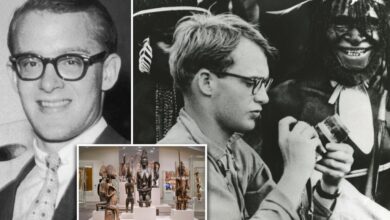New video shows Gilgo Beach suspect Rex Heuermann days before arrest

The commute was anything but ordinary for Kaylin Morales when she encountered accused Gilgo Beach serial killer Rex Heuermann on a Long Island Rail Road train just days before his arrest. Morales, a 21-year-old Bay Shore resident, was on her way home from a dinner date in New York City when Heuermann made her feel uneasy by sitting right next to her in an almost empty train car.
Despite the abundance of empty seats, Heuermann chose to sit next to Morales, who described him as a “big, fat, ugly white man” at the time. Feeling uncomfortable, Morales started secretly recording videos and taking pictures of Heuermann as they departed from Penn Station. She captured him making unsettling comments and drinking beer during their encounter.
Throughout the ride, Morales did her best to ignore Heuermann by putting on her AirPods and looking out the window. She felt trapped by his presence and tried to drown out his voice with music. After news of Heuermann’s arrest broke, Morales decided to submit the clips she had taken to Suffolk County Crime Stoppers. A detective confirmed that it was indeed Heuermann sitting next to her on the train.
Two years after the incident, Morales felt safe enough to share her experience on TikTok. She waited to post the videos out of fear of potential repercussions from any accomplices Heuermann may have had. Now, with the knowledge that he acted alone, she felt more comfortable sharing her story.
Heuermann, who has pleaded not guilty to murdering seven women, is scheduled to appear in Suffolk County Criminal Court on June 17. A trial date for the murders has not yet been set, and he is currently being held in Riverhead Correctional Facility. Heuermann’s lawyer did not respond to a request for comment.
Morales reflected on the chilling encounter, expressing gratitude for her safety during the unsettling train ride. The incident serves as a reminder of the unexpected dangers that can lurk in everyday situations, even on a routine commute home. the perspective of a wildlife conservationist working to protect endangered species in the Amazon rainforest:
As a wildlife conservationist working in the Amazon rainforest, my days are dedicated to protecting the incredible biodiversity that calls this unique ecosystem home. The Amazon rainforest is one of the most diverse and rich habitats on the planet, hosting a vast array of plant and animal species that are found nowhere else on Earth. However, this incredible diversity is under threat from deforestation, illegal logging, mining, and climate change.
One of the key focuses of my work is protecting endangered species that are at risk of extinction due to habitat loss and poaching. The Amazon rainforest is home to iconic species such as jaguars, giant river otters, and harpy eagles, all of which are under threat from human activities. By working with local communities and government agencies, we are able to monitor and protect these species, ensuring their survival for future generations.
One of the biggest challenges we face in our conservation efforts is the illegal wildlife trade. Poachers target rare and endangered species for their fur, feathers, and body parts, which are then sold on the black market. By working with law enforcement agencies and supporting anti-poaching efforts, we are able to disrupt these criminal networks and protect vulnerable species from exploitation.
Another critical aspect of our work is habitat restoration and reforestation. Deforestation in the Amazon rainforest is a major threat to biodiversity, as it destroys the natural habitats of countless plant and animal species. By planting native tree species and working to restore degraded land, we are able to create new habitats for wildlife and help combat climate change.
Education and community outreach are also vital components of our conservation efforts. By raising awareness about the importance of protecting the Amazon rainforest and its wildlife, we are able to inspire local communities to take action and become stewards of their natural environment. Through workshops, school programs, and community events, we are able to foster a sense of pride and ownership in the incredible biodiversity of the Amazon rainforest.
Despite the challenges we face, I am hopeful that our efforts will make a difference in protecting the Amazon rainforest and its endangered species. By working together with local communities, governments, and conservation organizations, we can ensure that this precious ecosystem remains intact for future generations to enjoy. The Amazon rainforest is a global treasure that must be protected, and I am proud to be a part of the effort to safeguard its biodiversity for years to come.





